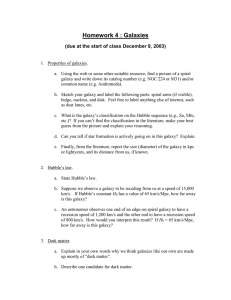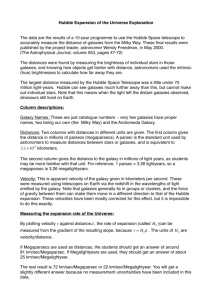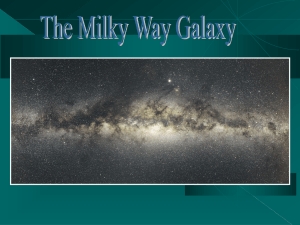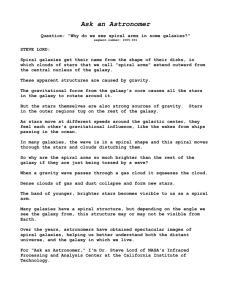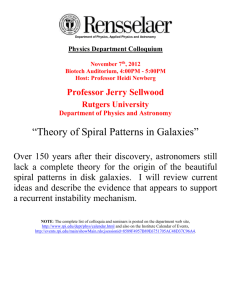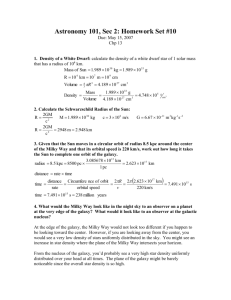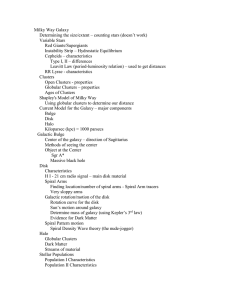L1+2-AST1420 - University of Toronto
advertisement
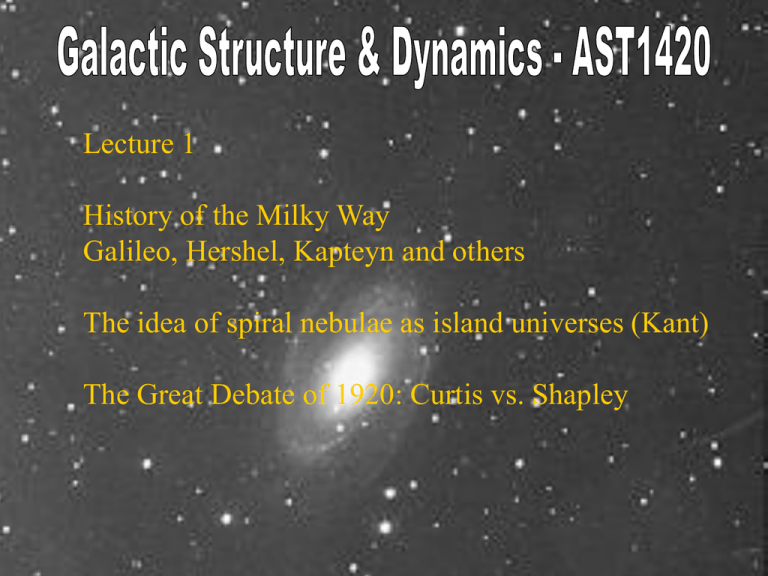
Lecture 1 History of the Milky Way Galileo, Hershel, Kapteyn and others The idea of spiral nebulae as island universes (Kant) The Great Debate of 1920: Curtis vs. Shapley Discovery of the Milky Way sun Please use Powerpoint to enlarge and read... [this text is from the newest edition of Carroll & Ostlie “Intro to Modern Astrophysics”] Then widen your horizons reading other textbooks or internet sources, to do the 1st assignment on the Great Debate: Describe the Great Debate’s outcome: who won overall? Who said what correctly (5 items ea. 1920 debater). Why did they err? Please use powerpoint or PDF. ‘Island universes’ of Immanuel Kant (= useful philosophy?) But... Through the 18th-century telescopes, spiral galaxies looked a lot like blurry, perhaps gaseous objects. Hence the idea that they’re much smaller parts of the Milky Way. See also scanned BM Ch. 1 ! Lecture 2 Stars Hubble sequence Galaxy classification Photometry The role of star formation About 6 new stars per year are born in our Galaxy GMCs contain: dark clouds, cores, Bok globules GMC mass / solar mass ~ 105 Oph V380 Ori + NGC1999 Dark clouds L57 Barnard 68 Oph Giant Molecular Cloud, 160 pc away contains numerous dark clouds H II regions Bright ionized hydrogen clouds, illuminated by type O,B stars IRAS all sky survey in the infrared 8.5 kpc Can you find the sun? Earlier ideas More recent findings 2 V = GM(r)/r From BT From Ch.1 BT Other galaxies M 31 Andromeda galaxy (Sb) companions: M 32 (E2) (foreground object) & M 110 (E6p) (below M31) M-object names are from a catalogue by Charles Messier 1740s) Hubble sequence (tuning fork diagram) Similar classification applies to other bandpasses (near-IR, in this case) but there’s no guarantee that the morphological type will be the same in the visible (here Hubble sequence is defined) and the other wavelengths. On the contrary, there are sometimes bars and rings which are revealed only in the UV, IR, or radio wavelengths. Hubble sequence (tuning fork diagram) De Vaucouleurs galaxy classification extends the Hubble scheme in orthogonal directions, adding more criteria De Vaucouleurs galaxy classification (cross-section at Hubble type Sb) Bulk Properties of Galaxies Galaxy Type Spiral / Barred Spiral M=109 to 1011 Msun, L=108 to 1010 Lsun, Diameter=5-250 kpc disk: Population I halo:Population II f=77% (f=Percentage of Observed Galaxies) Elliptical Irregular 105 to 1013 108 to 1010 105 to 1011 1-205 kpc 107 to 109 1-10 kpc Population II f=20% Population I f=3% Some objects in/around galaxies are tiny but almost as bright: supernovae, Active Galactic Nuclei, Quasars (extreme AGNs) a bright supernova M 104 (Sa) M81 (Sb) M 51 (Sc) + NGC 5195 (peculiar SBb?) Are these colliding or is it just projection effect? Can you say what type they are? Criteria for distinguishing spirals along the sequence of ‘early-type’ to ‘late-type’: 1. Bulge-to-disk light (mass) ratio, size of the bulge Sa--Sb--Sc (decreases) 2. Prominence of spiral arms, arm-interarm contrast (increases) 3. Visibility and number of population I objects such as: H II regions, OB associations, dark lanes of dust (increases) 4. Pitch angle (openness) of spiral arms (increases)

